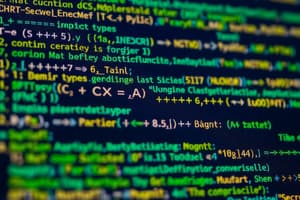Podcast
Questions and Answers
In C++, why is int 45abc; not a valid variable declaration?
In C++, why is int 45abc; not a valid variable declaration?
Variable names cannot start with a digit.
Explain the significance of the term 'radix' in the context of number systems.
Explain the significance of the term 'radix' in the context of number systems.
Radix indicates the base of a number system. It represents the total number of symbols in the system and the weightage or power of each digit.
Describe the primary purpose of using BCD (8421) code in computing.
Describe the primary purpose of using BCD (8421) code in computing.
BCD code represents each decimal digit with a 4-bit binary code. It helps to avoid long chain of 0 & 1, especially for larger numbers.
For a given binary number 11001010, what is its 1's complement?
For a given binary number 11001010, what is its 1's complement?
Explain how the 1's complement method facilitates subtraction using addition.
Explain how the 1's complement method facilitates subtraction using addition.
What is a flowchart? Briefly describe its purpose in programming.
What is a flowchart? Briefly describe its purpose in programming.
List three advantages of using flowcharts in the program development process.
List three advantages of using flowcharts in the program development process.
Briefly explain the role of the iostream header file in a simple C++ program.
Briefly explain the role of the iostream header file in a simple C++ program.
In C++, how does the compiler treat uppercase and lowercase variable names differently? Provide an example.
In C++, how does the compiler treat uppercase and lowercase variable names differently? Provide an example.
What is a 'preprocessor directive' and how it is used in C++ code?
What is a 'preprocessor directive' and how it is used in C++ code?
Explain the difference between an algorithm and pseudocode. How does pseudocode serve as a bridge between an algorithm and a program?
Explain the difference between an algorithm and pseudocode. How does pseudocode serve as a bridge between an algorithm and a program?
Describe three different data types available in C++, and provide an example scenario where each would be most appropriate.
Describe three different data types available in C++, and provide an example scenario where each would be most appropriate.
Explain what a variable is in C++, and describe the rules for naming variables.
Explain what a variable is in C++, and describe the rules for naming variables.
What is object-oriented programming (OOP), and what are its main advantages?
What is object-oriented programming (OOP), and what are its main advantages?
Briefly explain the concept of function overloading in C++ with example.
Briefly explain the concept of function overloading in C++ with example.
Describe the difference between pass by value and pass by reference when passing arguments to a function in C++.
Describe the difference between pass by value and pass by reference when passing arguments to a function in C++.
What are the key differences between while and do-while loops in C++?
What are the key differences between while and do-while loops in C++?
Explain the purpose of the new and delete operators in C++.
Explain the purpose of the new and delete operators in C++.
What is the purpose of a constructor in a C++ class, and how does it differ from a regular member function?
What is the purpose of a constructor in a C++ class, and how does it differ from a regular member function?
Explain what inheritance is in C++ and provide a simple example illustrating its use.
Explain what inheritance is in C++ and provide a simple example illustrating its use.
Flashcards
Invalid Variable Name
Invalid Variable Name
Variable names in C++ cannot start with a digit.
Case Sensitivity in C++
Case Sensitivity in C++
C++ treats uppercase and lowercase variable names as distinct.
Radix Definition
Radix Definition
The base of a number system, indicating the total symbols and the weight of each digit.
BCD 8421 Code
BCD 8421 Code
Signup and view all the flashcards
1's Complement
1's Complement
Signup and view all the flashcards
Flow Chart
Flow Chart
Signup and view all the flashcards
Advantages of Flow Charts
Advantages of Flow Charts
Signup and view all the flashcards
#include
#include
Signup and view all the flashcards
cout in C++
cout in C++
Signup and view all the flashcards
Structure of simple C++ program
Structure of simple C++ program
Signup and view all the flashcards
(11)₂ + (11)₂ + (11)₂ = ?
(11)₂ + (11)₂ + (11)₂ = ?
Signup and view all the flashcards
Algorithm
Algorithm
Signup and view all the flashcards
Pseudocode
Pseudocode
Signup and view all the flashcards
Object-Oriented Language (e.g., C++)
Object-Oriented Language (e.g., C++)
Signup and view all the flashcards
What is an algorithm?
What is an algorithm?
Signup and view all the flashcards
Algorithm to exchange values of two variables
Algorithm to exchange values of two variables
Signup and view all the flashcards
Data Types
Data Types
Signup and view all the flashcards
Primary (Built-in) Data Types
Primary (Built-in) Data Types
Signup and view all the flashcards
Derived Data Types
Derived Data Types
Signup and view all the flashcards
User-Defined Data Types
User-Defined Data Types
Signup and view all the flashcards
Study Notes
- (11)² + (11)² + (11)² = (1001)²
- Writing a program task in simple English is known as an algorithm.
- Pseudocode is midway between algorithm and program.
- C++ is an object-oriented language.
Algorithm
- An algorithm is a logical sequence of steps to solve a problem
- It is a tool written in simple natural language outlining job steps
- It isn't a programming language, but guides the programmer
- e.g., an Algorithm to exchange variable values:
- Given variables A and B
- Store A's value in X
- Transfer B's value to A
- Transfer X to B
Data Types in C++
- Variables use a data type during the declaration to restrict the type of data to be stored
- Data types tell variables what kind of data they can store
- In C++, when declaring a variable, the compiler allocates memory based on its data type
- Every data type requires a different amount of memory
- C++ supports a variety of data types, allowing programmers to choose types appropriate for the needs of their application
- Data types specify the size and type of values stored
- Storage representation and machine instructions vary but C++ instructions do not
Variable Declaration in C++
- Declaration involves the variable's name and data type
- Variables can be declared anywhere before they are used
- Syntax:
data-type var1, var2,...(e.g.,int varname;) - Variables can be optionally initialized upon declaration (e.g.,
float varname = 0;) - Multiple variables of the same type are declared in a comma-delimited list (e.g.,
char var1, var2;) - Valid variable names consist of alphabet letters, digits, and underscores, but cannot start with a number
- C++ treats uppercase and lowercase variables as different
Radix
- Radix indicates the base of a number system
- Represents the total symbols and weight or power of each digit
- The radix for the decimal system is 10 (symbols 0-9 with each digit in power of 10)
BCD 8421 Code
- BCD codes represent decimal numbers to avoid long binary chains for larger numbers
- 8421 BCD is commonly used in computer arithmetic
- Each decimal number is represented by a 4-bit code
- E.g.:
- 3 = 0011
- 5 = 0101
- 9 = 1001
- E.g.:
1's Complement
- Method can perform subtraction with addition and generate signed numbers.
- After subtraction, ones can easily verify the difference with the sign
- 1’s complement is obtained by replacing every 0 with 1, and every 1 with 0
- e.g., 1's complement of 101011 is 010100
Flowcharts
- After preparing an algorithm, for a given task it can be presented briefly as a pictorial form
- Flowcharts use standard symbols to represent an algorithm in pictorial form
- Flowcharts aid in formulating and understanding algorithms and illustrate different loops, logical decisions, along with input and output data
- Advantages:
- Better programming steps
- Systematic analysis resulting in effective testing, universal logical solutions of minimum length
- Minimization of errors
- Easy coding
Structure of a Simple C++ Program
-
Include Header:
#include <iostream.h>includes the iostream header file (Input Output stream) that is a preprocessor directive to support input/output functions -
Main function:
void main(), is where programme starts writing- Every C++ program has one main function
-
Program Body:
{ cout << "Hello and Welcome to world of C++\n"; }contains the program's instructions
- The
coutstatement displays the text on the screen
- The
Constants in C++
- Constants are fixed-value variables that can't be changed during program execution
- Stored as read-only tokens in the code segment of memory
- Can be any available data type like int, char, string, etc.
Types of Constants
- Integer Constants : Integer with a fixed, non-fractional value (e.g.,
const signed int limit = 20;) - Floating or Real Constants: Represents real numbers, including fractional values (e.g.,
const long float pi = 3.14159;) - Character Constants: Characters, digits, or special symbols within single quotes. (e.g., '+', 'A', 'd'.)
- Each has an associated ASCII value
- String Constants: Array of characters enclosed in double quotes (e.g.,
"DataFlair","Hello world!") - Enumeration Constants: User-defined data types with fixed value used to assign names to integral constants
- e.g.,
enum rainbow = { Violet, Indigo, Blue, Green, Yellow, Orange, Red }
- e.g.,
Algorithm to Determine if a Number is Prime
- Input number n
- If n < 1, number is not prime and stop
- If n = 2, it is prime and stop
- Let I = 2
- Repeat:
- Divide n by I: if remainder is 0, then n isn't prime and stop
- Increment I by 1 until I <= N - 1
- Stop
Compiler Tokens
- A program is broken into tokens
- A token is recognizable by the compiler
- Five categories:
- Keywords
- Literals
- Identifiers
- Operators
- White space
Variables: Declaration vs. Initialization
- Declaration associates a name and data type with a variable.
- Initialization assigns it a value.
Structured Programming
- Developed in a hierarchy of modules
- Modules are subprograms in the main program
- A top-to-bottom approach:
- A simple sequence
- Selection by decision
- A repetition
Modular Programming
- A main module is prepared by writing instructions of control
- Submodules are prepared by writing required programs in the main program
- Each subprogram may be called as "Functions" or "Procedurcs"
- Each function performs a routine, which may be required many times in the main program.
Comments in C++
- Used to make programs readable
- Compiler ignores comments, which don't impact file size or execution time
- Single line comment: */ comments here
- Multline comment. // multi line comment here
Sorting
- A process of arranging data items in ascending or descending order
Sorting Algorithms Overview
- Arrange elements in ascending or descending order in an array, a list, or any other data structure
- Different sorting algorithms include:
- Sorting by selection
- Bubble sorting
- Shell sorting
- Heap sorting
Bubble Sort
- Bubble sort involves the steps:
- compare A[1] and A[2] and arrange them in desired order so that A[I]<A[2]. Continue this comparison until A[N-1] with A[NI and arrange them so that A[N-1]<A[N].
- Repeat step 1 with one less comparison. Now we stop after we compare A[N-2] and A[N-1],
- Compare A[1] with A[2] so that, A[1]< A[2]. After N-1 steps the list will be sorted in increasing order.
Binary Search
- For searching in a sorted list
- Elements are asumed to be arranged in ascending order
- Procedure includes:
- calculating the mid point element's position
- comparing desired value with the mid point element:
- If it's less, reduce the search in the second half of the interval, centered on mid point
- Repeat if the interval isn't empty
- On successful search, output the position
Studying That Suits You
Use AI to generate personalized quizzes and flashcards to suit your learning preferences.




